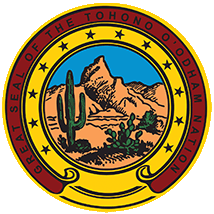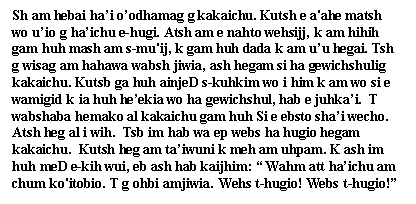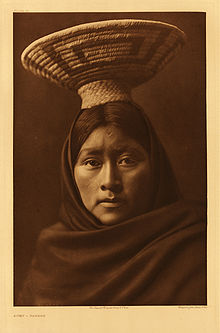To view this page in another language, please click here:
Tohono
O'odham (Papago)
Literature
In O'odham language, "Tohono O'odham" means "Desert People."
The Tohono
O'odham
are a group of Native American people who reside primarily
in the
Sonoran Desert of the southeastern Arizona and northwest
Mexico.
"Tohono O'odham" means "Desert People."
Although the Tohono
O'odham
were previously known as the Papago, (meaning literally
"tepary-bean
eater"), they have largely rejected this name. It was
applied to them
by conquistadores who had heard them called this by other
Piman bands
that were very competitive with the Tohono O'odham. The
term Papago
derives from Ba:bawĭkoʼa, meaning "eating tepary beans."
That word was
pronounced Papago by the Spanish.
The Tohono O'odham Nation, or Tohono O'odham Indian
Reservation, is
located in southern Arizona, encompassing portions of Pima
County,
Pinal County, and Maricopa County.
The
Tohono O'odham share linguistic and cultural roots with
the closely
related Akimel O'odham (People of the River), whose lands
lie just
south of Phoenix, along the lower Gila River. The
Sobaipuri are
ancestors to both the Tohono O'odham and the Akimel
O'odham who resided
along the major rivers of southern Arizona. Ancient
pictographs adorn a
rock wall that juts up out of the desert near the
Baboquivari Mountains.
Debates surround the origins of the O'odham. Claims that
the O'odham
moved north as recently as 300 years ago compete with
claims that the
Hohokam, who left the Casa Grande Ruins, are their
ancestors. Recent
research on the Sobaipuri, now extinct relatives of the
O'odham, shows
that they were present in sizable numbers in the southern
Arizona river
valleys in the fifteenth century.
Collection of Poems
1937 is the year in which the original constitution and by-laws of the Papago Tribe was approved by the United States Department of the Interior. 1986 represents the year in which the Nation adopted a new constitution and changed its name from the Papago Tribe to the Tohono O'odham Nation. The inside picture has a view of the sacred mountain, Baboquivari Peak, home of I'itoi. Also in view is a saguaro, prickly pear and barrel cactus from which the O'odham pick fruit and have various uses from each of these cactus to cook and use for building materials.
The Tohono O'odham share linguistic and cultural roots with the closely related Akimel O'odham (People of the River), whose lands lie just south of Phoenix, along the lower Gila River. The Sobaipuri are ancestors to both the Tohono O'odham and the Akimel O'odham who resided along the major rivers of southern Arizona. Ancient pictographs adorn a rock wall that juts up out of the desert near the Baboquivari Mountains.
Debates surround the origins of the O'odham. Claims that the O'odham moved north as recently as 300 years ago compete with claims that the Hohokam, who left the Casa Grande Ruins, are their ancestors. Recent research on the Sobaipuri, now extinct relatives of the O'odham, shows that they were present in sizable numbers in the southern Arizona river valleys in the fifteenth century.
Images

The Tohono O'odham (Papago) nation's native word papah, beans, is the source for being called the "bean people." They belong to the Piman branch of the Uto-Aztecan linguistic family, and are closely related to the Pima tribe southeast of the Gila River and south of Tucson, Arizona, and extending west and southwest across the desert Papagueria on into Sonora, Mexico. In 1694, Father Kino became the first white man to visit the Tohono O'odham (Papago) nation, finding a very large population into the thousands. Census figures in 1937 listed 6,305 members of the Tohono O'odham (Papago) nation.
The desert people (as they are called), recently reestablished their ancestral name after many years of being known as Papagos. They reside in a portion of the northwestern Sonoran Desert. Their ancestral homelands bridge the international border of Mexico and the United States; however, in 1916 the United States defined for them a four-part Reservation of 4,462 square miles in southern Arizona. Recent estimates approximate the tribal population on the Reservation to be between 7,500 and 12,000 with about 2,000 living in Sells, the largest community.
Their land is the hottest of North American deserts. Hot summers, cool winters, extreme diurnal temperature fluctuations, low humidity, high evaporation and a biannual rainfall pattern dictate strategies for maintaining human comfort. At Sells mean daily temperatures range between 72° F to 10° F in July and 36° F to 65° F in January. Water evaporation from an open tank can exceed 6 ft. annually. Sells receives a yearly precipitation of about 12 inches with approximately the same amounts falling during the winter and summer rainy seasons.
The Papago women who weave baskets continue their ancient art form mainly for economic survival. One of the weavers indicated that she weaves to sell baskets in order to support her family. She sells to traders who come to her home. As is true of most Papago weavers, she is willing to create new designs and innovate her work to please the demand of the market. Therefore, instead of doing the time-consuming tight stitched baskets, many weavers do the split stitch because they can weave more baskets in the same time.
They have their own printed alphabet and language studies:
She has actively worked with her tribe to improve literacy in their native language and in English.

Stories
Desert Indian WomanEvery February, annually, the Sells Rodeo and Parade is held in the capital of the Nation. The rodeo has been an annual event for 73 years. February 2012 was the 74th year the Nation has held the Event.
In the visual arts, Michael Chiago and the late Leonard Chana have gained widespread recognition for their paintings and drawings of traditional O'odham activities and scenes. Chiago has exhibited at the Heard Museum and has contributed cover art to Arizona Highways magazine and University of Arizona Press books. Chana illustrated books by Tucson writer Byrd Baylor and created murals for Tohono O'odham Nation buildings.
In
2004, the Heard Museum awarded Danny Lopez its first
heritage award,
recognizing his lifelong work sustaining the desert
people's way of
life. At the National Museum for the American Indian
(NMAI), the Tohono
O'odham were represented in the founding exhibition
and Mr. Lopez
blessed the exhibit.
Slide Show
Tohono O'odham Baskets
Tohono O'odham Community College
Tohono O'odham / Papago
The Tohono O'odham Nation
Tohono O'odham Nation Maps
O'odham Sacred Site of Quitovac
O'odham language
How To Speak Tohono O'odham
A Native American Indian Indigenous Language
Constitution
Now numbering more than 25,000 enrolled members, the Tohono O'odham Nation gains most of its income from its three Desert Diamond casinos. This source of income is just over a decade old. It has paid for the tribe's first fire department, but the casinos cannot cover the numerous basic needs of tribal members. Housing, emergency services, medical, and educational needs require expensive infrastructure, including transportation, personnel, education, and technology. The physical isolation of the Nation has always been a handicap to its economic development.
![]() Return to Indigenous Peoples'
Literature
Return to Indigenous Peoples'
Literature
Compiled by: Glenn
Welker
ghwelker@gmx.com
This site has been accessed 10,000,000 times since February 8, 1996.
This page last updated 05/25/2019 16:02:16

